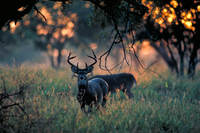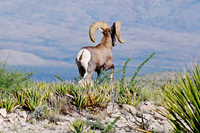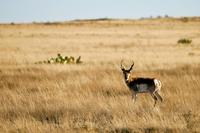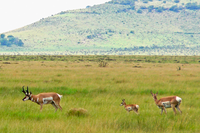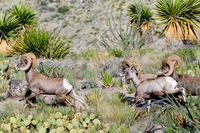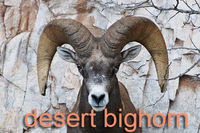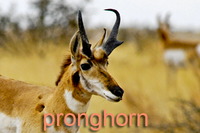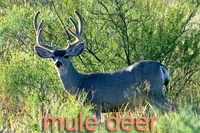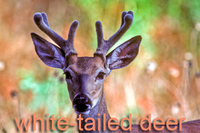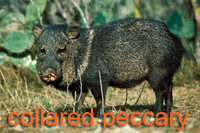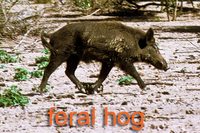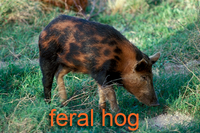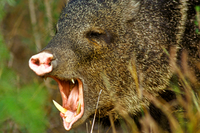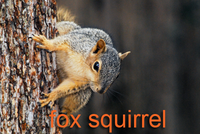Game Animals
Texas is blessed with a wide variety of wildlife. Purchasing a hunting and fishing license allows you to harvest and enjoy some of these wonderful animals, along with funding TPWD conservation programs. The major game animals in Texas are white-tailed deer, mule deer, desert bighorn sheep, pronghorn antelope, gray or cat squirrel, red or fox squirrel, and collared peccary or javelina.
Hunters have a chance to win some spectacular hunts for some of these species by entering the Big Time Texas Hunts program.
White-tailed Deer
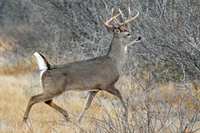 Aesthetically and emotionally, the whitetail holds a place of distinction in the hearts and minds of many Texans. The Texas white-tailed deer, Odocoileus virginianus texana, occurs almost statewide. The white-tailed deer is now the most numerous big game animal in Texas and in the United States. Texas has more white-tailed deer than any other state. Population estimates in recent year range from three to four million. An estimated 430,000-500,000 whitetails are harvested by sportsmen in Texas annually – more than any other state. Harvest limits for bucks and antlerless deer vary by county and many counties have antler restrictions.
Aesthetically and emotionally, the whitetail holds a place of distinction in the hearts and minds of many Texans. The Texas white-tailed deer, Odocoileus virginianus texana, occurs almost statewide. The white-tailed deer is now the most numerous big game animal in Texas and in the United States. Texas has more white-tailed deer than any other state. Population estimates in recent year range from three to four million. An estimated 430,000-500,000 whitetails are harvested by sportsmen in Texas annually – more than any other state. Harvest limits for bucks and antlerless deer vary by county and many counties have antler restrictions.
Be sure to fill in the white-tailed deer log on the back of your license for each white-tail you harvest. Check individual county listings in the Outdoor Annual.
White-tails signal their flight by raising their tail and carrying it erect as they evade a perceived danger. This is called “flagging.” White-tailed deer in northern states have larger bodies than Texas white-tailed deer. This is known as Bergmann’s rule, principle that animals living in a cold climate tend to be larger than individuals of that same species living in a warm climate. Learn more about white-tailed deer.
Mule Deer
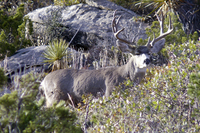 The mule deer, Odocoileus hemionus, is a different species from white-tailed deer. Mule deer occur primarily west of the Pecos River and in parts of the High Plains of the Texas Panhandle. Despite increased numbers and range expansion over the last 60 years, mule deer continue to experience significant population fluctuations. In recent years, substantial population decreases have occurred throughout west Texas. Mule deer numbers in the Trans-Pecos reached a low of 95,000 animals in 1999. Wildlife experts believe that these declines are the result of extended drought, lack of available quality forage and loss of cover. Proper habitat management is the most important factor in maintaining viable mule deer populations in Texas.
The mule deer, Odocoileus hemionus, is a different species from white-tailed deer. Mule deer occur primarily west of the Pecos River and in parts of the High Plains of the Texas Panhandle. Despite increased numbers and range expansion over the last 60 years, mule deer continue to experience significant population fluctuations. In recent years, substantial population decreases have occurred throughout west Texas. Mule deer numbers in the Trans-Pecos reached a low of 95,000 animals in 1999. Wildlife experts believe that these declines are the result of extended drought, lack of available quality forage and loss of cover. Proper habitat management is the most important factor in maintaining viable mule deer populations in Texas.
The body weights of mule deer are generally larger than white-tailed deer. Their ears are noticeably larger, which is where they get their name. The dates for mule deer season are different from the white-tailed deer season and also have varying harvest limits for bucks and antlerless deer by county. Check individual county listings in the Outdoor Annual.
Chronic Wasting Disease
In July of 2012, samples from two mule deer recently taken in far West Texas have been confirmed positive for Chronic Wasting Disease (CWD). These are the first cases of CWD detected in Texas deer. Wildlife officials believe the event is currently isolated in a remote part of the state near the New Mexico border. Both infected deer were taken from the Hueco Mountains of northern El Paso and Hudspeth counties.
CWD is a member of the group of diseases called transmissible spongiform encephalopathies (TSEs). Other diseases in this group include scrapie in sheep, bovine spongiform encephalopathy (BSE or mad cow disease) in cattle, and Cruetzfeldt-Jakob disease in humans. CWD among deer is a progressive, fatal disease that commonly results in altered behavior as a result of microscopic changes made to the brain of affected animals. The disease cannot be diagnosed by symptoms alone since any neurological disorder will exhibit similar symptoms. A portion of the brain or lymph nodes found in the throat of an animal must be tested to confirm if the animal in question is infected with CWD. Unfortunately, there is no live-animal test to detect CWD. Symptoms of infected animals include: emaciation, excessive salivation, lack of muscle coordination, difficulty in swallowing, and excessive thirst and urination. Clinically-ill animals may have an exaggerated wide posture, may stagger and carry the head and ears lowered, and are often found consuming large amounts of water. However, as previously noted, these symptoms are similar to numerous toxic or neurological afflictions so diagnosis cannot be made by symptoms alone. CWD is not known to affect humans.
What should I do if I see a deer that shows symptoms of CWD?
Accurately document the location of the animal and immediately contact the nearest TPWD Wildlife Division or Law Enforcement Division office or call TPWD headquarters in Austin toll-free at (800) 892-1112 and enter 5 for wildlife and 1 for general wildlife information. Or contact TAHC toll-free at (800) 550-8242. Do not attempt to touch, disturb, kill or remove the animal.
Pronghorn
Found only in North America, the American pronghorn once ranged the prairies and deserts west of the Mississippi River from southern Canada, across the Rocky Mountains and south to central Mexico. Original numbers are estimated between 30-40 million animals. Today, Texas pronghorn populations are restricted to the Trans-Pecos, Panhandle and southern Rolling Plains ecoregions.
Pronghorn numbers across the west are declining once again; numbers in the Trans-Pecos are at a 20-year low. Timely and adequate rainfall remains an integral element in maintaining the vitality and viability of antelope populations. Net wire fences, a legacy of past large scale grazing of sheep and goats, continues to present a serious problem to the free movement of pronghorns in the Trans-Pecos. A pronghorn's primary means of defense against predators are their vision and speed. Pronghorn do not know they have the ability to jump net wire fences. Therefore, when food is inadequate resulting from improper livestock grazing and/or persistent drought, they rarely jump net wire fences in attempts to find food like mule deer. Pronghorn sometime get caught in fences attempting to access suitable forage, cover, or sanctuary. Rarely do those that have found access to forage in highway right-of-ways, survive today's traffic. In Texas pronghorn may be hunted by permit only. Permits are issued only to the landowner or landowner’s agent in selected areas of Trans-Pecos, Permian Basin, and Panhandle counties. Check individual county listings in the Outdoor Annual.
Desert Bighorn Sheep
Desert bighorn sheep historically occupied most of the mountain ranges of the Trans-Pecos region. Bighorn numbers in the late 1800s were estimated as high as 1,500 animals. By the early 1900s, most Texas bighorn populations declined and the last documented sighting of a native bighorn occurred in 1958. Restoration efforts for bighorn sheep were initiated in 1954 with the development of a cooperative agreement between federal and state agencies and private conservation interests. Since 1959, desert bighorn sheep have been transplanted from several states and Mexico into Texas’ mountain ranges.
The Trans-Pecos currently supports seven free-ranging populations of desert bighorn sheep. Recent surveys indicate an population of 1300 sheep. Desert bighorn sheep hunting was reinstated in 1988. Hunting desert bighorn sheep is by permit only in Brewster, Culberson, Hudspeth, Jeff Davis and Presidio counties. Sheep are adapted to harsh desert environments, but water availability is considered to be the most limiting factor in the survival of the desert bighorn. Restoration and management are supported by committed partners including the Bighorn Sheep Society, but private landowner management remains the single most important factor in maintaining viable bighorn sheep populations.
Antlers vs. Horns
Horns and antlers are both hard objects that protrude from the heads of various mammals, but the two growths are not alike. A horn has a bony center or core. From the base of it grows a covering of hardened, modified cells called keratin. Horns are rarely shed and usually continue to grow throughout an animal's lifetime. Both males and females may have them, but the female's usually are smaller and less impressive. Most hoofed animals – such as cattle, sheep, goats, and their wild relatives – grow horns. Pronghorn also grow horns, but theirs are slightly different. They, too, have a keratin sheath covering a bony core, but a new sheath grows each year, pushing off the old one shortly after the breeding season is over. The male's horns are branched (pronged), while the female's are smaller and seldom pronged.
Unlike horns, antlers are solid bone and are grown only by members of the deer family. Normally only the males grow them; however, female reindeer and caribous are exceptions. These females generally use their antlers to push others away from the best feeding spots, especially when food is scarce. Males primarily use their antlers for fighting each other during the breeding season. Antlers are shed each year after breeding season and must be replaced with a new set grown the following year. From the time the new antlers begin growing from the pedicels until they reach their full size, they are covered with a soft skin called "velvet." Tiny blood vessels in the velvet bring food and minerals to the growing antlers. An antler in velvet is soft, tender, easily injured, and will bleed if cut. Bucks make every effort to protect their growing antlers; a serious injury could produce a deformed set. Once the three-month, rapid-growth period is over, the antlers begin to harden (mineralize) beneath the velvet. By September the fully developed antlers have hardened, and the buck's body starts getting ready for the breeding season.
Collared Peccary or Javelina
There are three species of peccaries that range from the Southwestern United States south to central South America. The only species found in the United States is the collared peccary, or javelina. In Texas, the javelina is found in the more arid or semi-arid parts of the state, with most occurring in the South Texas brush country, the Trans-Pecos' desert grasslands, and the Edwards Plateau's oak-juniper woodlands.
Javelina have the appearance of a small, thin, rangy domestic pig without a visible tail. Both male and female collared peccary have a “collar” of white and black hairs around the neck and shoulder that stands out from the normally darker coat, giving the species its name. They are often mistaken for feral hogs but feral hogs have noticeable tails, larger ears, and come in a variety colors. Javelina are much smaller than they appear, with an average adult standing 18 inches tall and weighing between 35 to 45 pounds, although individuals in the 50- to 60-pound range have been documented. Size may vary throughout their range due to annual precipitation and food abundance. Javelina have small eyes and poor eyesight, and have difficulty recognizing objects over 100 yards away. They also have a poor sense of hearing; however, their sense of smell is highly developed.
Males and females possess impressively straight self-sharpening upper and lower canine teeth, which serve little purpose in eating. They are used principally for defense and threat postures such as the “gape” (opening the mouth and showing teeth) and “chattering” or “clacking” of the teeth (a staccato movement of the jaws used in intimidation). Other unique characteristics of javelina include the presence of a dorsal scent gland located six to seven inches above the tail. This gland is present on both male and female but removes with the pelt when skinned. In the north of Texas there is an open season, in the south, there is no closed season (they may be hunted year round). All other counties are closed. The bag limit is 2 per year. Check individual county listings in the Outdoor Annual.
Squirrel
The gray, or cat squirrel and the red, or fox squirrel, are considered game animals in Texas. Check the Outdoor Annual for season and bag limits.
